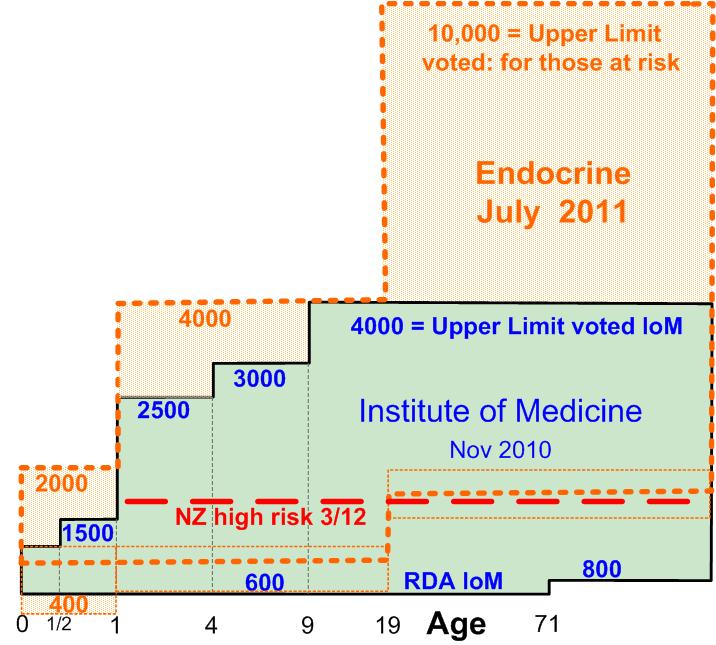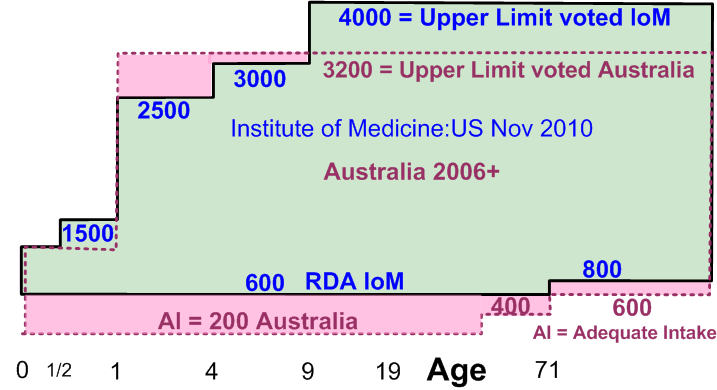New Zealand consensus: at risk should take more Vitamin D
Consensus Statement
(note: very little is said on their Consensus|web page
Consensus Statement on Vitamin D and Sun Exposure in New Zealand.
Issued by Ministry of Health and Cancer Society of New Zealand, Wellington, March 14, 2012
Summary:
< 10 ng = deficient
20 ng = prudent: 32% of the entire population of New Zealand had vitamin D levels less than 20 nanograms/ml in 2009
higher than 50 ng not recommended
All at risk people in NZ should have a 50,000 IU vitamin D3 monthly prescription
It is important to note that:
A great many organizations and countries place 30 nanograms as the minimum
Winter would increase the percentage (less sun)
They failed to mention many high risk groups: e.g. as seniors (senior skin is 1/3 as efficient at making vitamin D)
Higher percentage would be deficient in their island which is further from the equator (less sunshine)
Probably more have become deficient by 2012 (since 2009)
- 26 reasons for deficiency - 12 of which are new in the past 40 years
Based on data from many other countries which you can find in Vitamin D Life (NZ did not release their data) we anticipate:
>90% less than 30 nanograms on the Southern (less sunny) island in the winter
For those in a high risk group (dark skin, senior, pregnant, obese)
Consensus statement does NOT recommend widespread testing vitamin D levels (we agree – testing not needed)
They recommend getting it only by prescription (we disagree)
The consensus statement talks about getting 50,000 IU of vitamin D3 monthly, which is only 1,600 IU daily .
The statement notes that number of people in NZ getting this prescription Vitamin D3 has
Increased by 2X from 2007 to 2010.
If we assume that it has doubled again since then,
8% of all New Zealanders had a vitamin D prescription BEFORE the release of this consensus statement
A much better dose to suggest for at-risk New Zealanders would have been 50,000 IU twice a month.
(3,200 IU is less than the upper limit recommended for all people in the US)
The NZ consensus statement FAILED TO:
- mention the vital importance of vitamin D co-factors
- principally 500 mg Calcium, 500 mg Magnesium, and some Vitamin K2
- suggest checking for possible allergic reaction to vitamin D (about 1 in 300 people)
- Should try just a tiny portion of the capsule and wait several days to see if there is an allergic reaction
- Importance of how and when to take the vitamin D - can increase the benefit by 2X if take with almonds, etc.
They are under great restriction to recommend more vitamin D due to the intense Slip/Slop/Slap campaign
which has been underway in New Zealand and Australia for the past 40 years.
At some future time NZ will be making a statement about vitamin D needs for those who are pregnant.
(Hint: from many studies on Vitamin D Life 6,400 IU daily = approx 50,000 IU once a week)
CLICK HERE for PDF of the consensus statement of March 14, 2012
CLICK Q&A; from NZ is attached at the bottom of this page
New Zealand still has a long ways to go for all of the population

Australia noticed a similar deficiency 3 months before NZ: 73 % of Australians had < 30 ng of vitamin D
Again, would be even higher percentage of those in Australia at high risk, high latitude, etc. etc.
Unfortunately, Australia continues to have AI (Adequate Intake) = 200 IU of vitamin D
- which is not enough for ANYONE to achieve a level of 30 ng of vitamin D
Even the conservative US says that 600 IU is needed to get to 20 ng of vitamin D

See also Vitamin D Life
Majority of those living in the ozone hole lack vitamin D blog post March 2012
Many reasons why vitamin D deficiency has become epidemic 12 new reasons
90 % of young health care professionals had less than 30 ngof vitamin D – Nov 2011
87 % of Tennessee general medicine patients had less than 32 ng of vitamin D – Jan 2011
82 % of African immigrants to Melborne had less than 20 ng of vitamin D
82 % of black US adults less than 20 ng of vitamin D – Jan 2011
80 % of teens in Europe had less than 30 ng of vitamin D – Aug 2011
79 % of middle aged Americans had less than 32 ng of vitamin D – July 2010
75 % of children in NE US had less than 20 ng of vitamin D in winter – Dec 2011
45 % of Tasmanian adults < 20 ng vitamin D in the winter – April 2012
Vitamin D <20 ng in UK youths – 37X more likely if dark skin – July 2011
Cancer patients 64% less likely to die if have high level of vitamin D – Dec 2011
“Sunlight Officers” in some Australian senior facilities – Sept 2011
Most Australian GPs still believe the myth than 10 minutes of sun a day is enough – June 2011
Huge increase in food allergies in Australia may be due to low vitamin D
Vitamin D deficiency and testing in Australia are epidemics - Aug 2011
50,000 IU vitamin D monthly helped those lacking sun – Jan 2012 for people living in Antarctic who get NO sun
Black Sudanese children 350X more likely to have rickets than white Australians – April 2012
Vitamin D Recommendations which has the following graph of recommendations

Note: ALL 25 of the recommendations are greater than the 20 ng recommended by govts of Australia and the US
Percent of population with less than 20 ng of vitamin D has the following chart

However on the other side of the world
Half of seniors did not respond to 1600 IU of vitamin D daily for a year
RED square = reduction in serum level

from slide presentation: https://www.Vitamin D Life.com/tiki-index.php?page_id=2269
